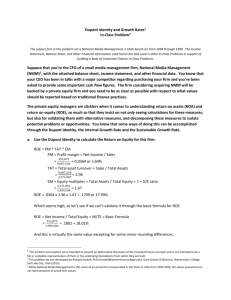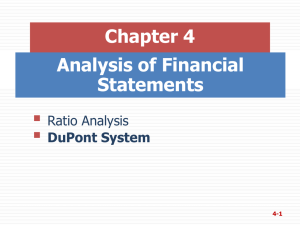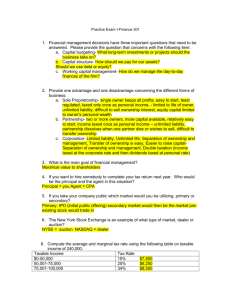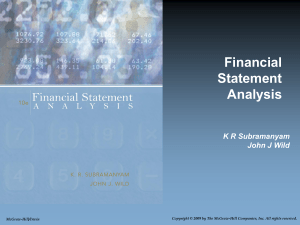Profitability Ratios
advertisement
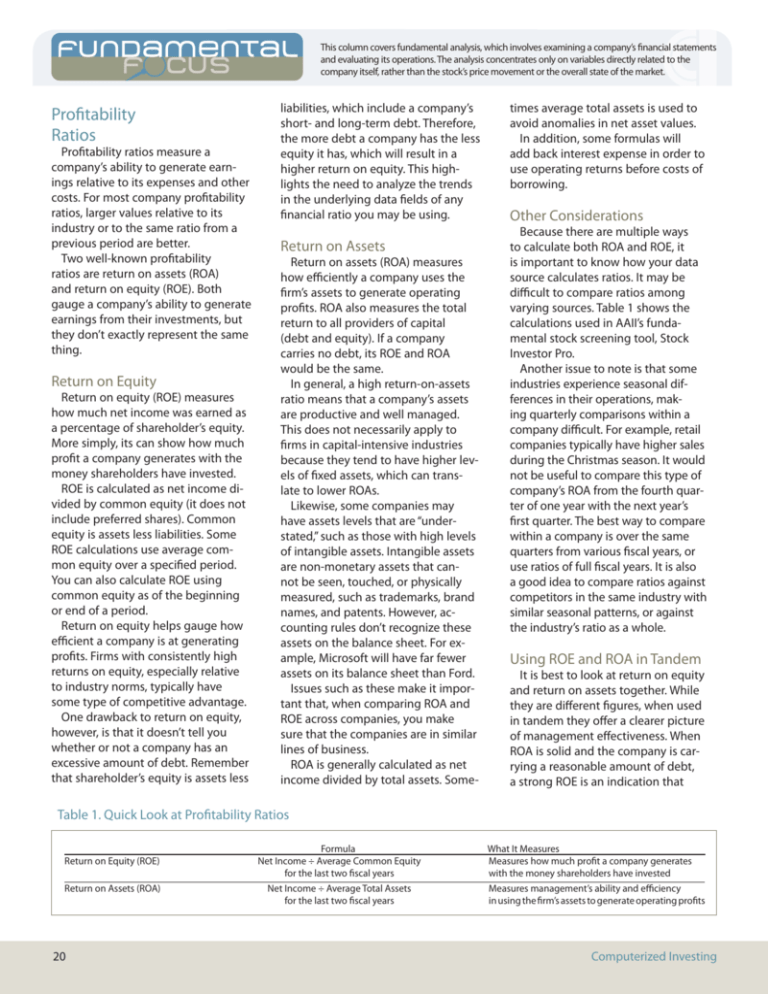
This column covers fundamental analysis, which involves examining a company’s financial statements and evaluating its operations. The analysis concentrates only on variables directly related to the company itself, rather than the stock’s price movement or the overall state of the market. Profitability Ratios Profitability ratios measure a company’s ability to generate earnings relative to its expenses and other costs. For most company profitability ratios, larger values relative to its industry or to the same ratio from a previous period are better. Two well-known profitability ratios are return on assets (ROA) and return on equity (ROE). Both gauge a company’s ability to generate earnings from their investments, but they don’t exactly represent the same thing. Return on Equity Return on equity (ROE) measures how much net income was earned as a percentage of shareholder’s equity. More simply, its can show how much profit a company generates with the money shareholders have invested. ROE is calculated as net income divided by common equity (it does not include preferred shares). Common equity is assets less liabilities. Some ROE calculations use average common equity over a specified period. You can also calculate ROE using common equity as of the beginning or end of a period. Return on equity helps gauge how efficient a company is at generating profits. Firms with consistently high returns on equity, especially relative to industry norms, typically have some type of competitive advantage. One drawback to return on equity, however, is that it doesn’t tell you whether or not a company has an excessive amount of debt. Remember that shareholder’s equity is assets less liabilities, which include a company’s short- and long-term debt. Therefore, the more debt a company has the less equity it has, which will result in a higher return on equity. This highlights the need to analyze the trends in the underlying data fields of any financial ratio you may be using. Return on Assets Return on assets (ROA) measures how efficiently a company uses the firm’s assets to generate operating profits. ROA also measures the total return to all providers of capital (debt and equity). If a company carries no debt, its ROE and ROA would be the same. In general, a high return-on-assets ratio means that a company’s assets are productive and well managed. This does not necessarily apply to firms in capital-intensive industries because they tend to have higher levels of fixed assets, which can translate to lower ROAs. Likewise, some companies may have assets levels that are “understated,” such as those with high levels of intangible assets. Intangible assets are non-monetary assets that cannot be seen, touched, or physically measured, such as trademarks, brand names, and patents. However, accounting rules don’t recognize these assets on the balance sheet. For example, Microsoft will have far fewer assets on its balance sheet than Ford. Issues such as these make it important that, when comparing ROA and ROE across companies, you make sure that the companies are in similar lines of business. ROA is generally calculated as net income divided by total assets. Some- times average total assets is used to avoid anomalies in net asset values. In addition, some formulas will add back interest expense in order to use operating returns before costs of borrowing. Other Considerations Because there are multiple ways to calculate both ROA and ROE, it is important to know how your data source calculates ratios. It may be difficult to compare ratios among varying sources. Table 1 shows the calculations used in AAII’s fundamental stock screening tool, Stock Investor Pro. Another issue to note is that some industries experience seasonal differences in their operations, making quarterly comparisons within a company difficult. For example, retail companies typically have higher sales during the Christmas season. It would not be useful to compare this type of company’s ROA from the fourth quarter of one year with the next year’s first quarter. The best way to compare within a company is over the same quarters from various fiscal years, or use ratios of full fiscal years. It is also a good idea to compare ratios against competitors in the same industry with similar seasonal patterns, or against the industry’s ratio as a whole. Using ROE and ROA in Tandem It is best to look at return on equity and return on assets together. While they are different figures, when used in tandem they offer a clearer picture of management effectiveness. When ROA is solid and the company is carrying a reasonable amount of debt, a strong ROE is an indication that Table 1. Quick Look at Profitability Ratios Return on Equity (ROE) Return on Assets (ROA) 20 Formula Net Income ÷ Average Common Equity for the last two fiscal years Net Income ÷ Average Total Assets for the last two fiscal years What It Measures Measures how much profit a company generates with the money shareholders have invested Measures management’s ability and efficiency in using the firm’s assets to generate operating profits Computerized Investing Figure 1. Amazon.com Profitability Ratios on Morningstar.com Source: Morningstar.com. Data as of 9/31/2009. management is doing a good job of generating returns from shareholders’ investment. However, if ROA is low and the company is overburdened with debt, a high ROE can mislead investors into thinking things are better than they actually are. and ROE for the last seven fiscal years along with industry medians from Stock Investor Pro. As you can see, Amazon’s ROA was fairly low in 2003. In fact, it was negative for multiple years prior. During these years, Amazon.com was spending more than it made, which is not uncommon for a start-up company (the company started in 1994 and went public in 1997). The company was losing money and purchasing assets during its first years. Amazon.com’s first profitable year was 2003. The ROA jumped to a high of 21.8% in 2004 when Amazon had its second most profitable year. Amazon had its most profitable year in 2008, but it also increased its assets by 125%, dragging down the ROA to 8.7%. These numbers indicate that Amazon may have been better at turning its assets into revenues in 2004 than it was in 2008. As for Amazon’s ROE, the company had negative shareholder’s equity (the value of its assets was less than its liabilities) until 2005, making its ROE negative. Looking at 2007 and 2008, you can see that the ROE is 58.5% and 33.3%, respectively. If Amazon was so profitable in 2008, why was its return on equity much lower than in 2007? Amazon issued 7.8 million Where to Find the Data shares of stock during 2008. AAII’s Stock Investor Pro reports Comparing Amazon’s ROA and ROE and ROA data for the trailing ROE to its industry ratios, you can 12 months and the last seven fiscal see that Amazon has recently been years and gives five-year and sevenbeating the retail industry’s averyear averages. It also shows sector ages. However, taking a closer look and industry ratios for comparison. at Amazon’s financials shows that Morningstar.com also provides ROE starting in 2007, the company took and ROA data as well as comparion a lot of debt. As discussed earlier, sons to industries. Simply enter the higher levels of debt can inflate ROE. ticker symbol into the Search box and As for ROA, you can see that when choose “Key Ratios.” Figure 1 shows Amazon became profitable in 2003, ROE and ROA statistics for Amazon. its ROA became positive and since com, Inc. for the last 10 years as 2004 has been higher than the indusreported on Morningstar.com. try average. As an on-line company, Amazon has less physical assets than Applying the Concepts other retailers with store locations, Table 2 shows Amazon’s ROA which could account for the high ROA as compared to other retailTable 2. Return on Assets & Return on Equity for Amazon.com, Inc. (M: AMZN) ers. In this case, it would be useful to compare Amazon’s ratios TTM 2008 2007 2006 2005 2004 2003 2002 to another on-line retailer with a Amazon.com ROA (%) 9.3 8.7 8.8 4.7 10.3 21.8 1.7 (8.2) Industry ROA (%) (2.4) (3.0) 1.8 3.2 3.4 5.2 5.6 5.8 similar structure. Amazon.com ROE (%) 23.9 33.3 58.5 56.1 nmf (93.2) (3.0) 10.7 This example illustrates that it Industry ROE (%) 0.0 (2.0) 11.4 11.7 10.0 11.8 12.3 13.1 is just as important to understand the inputs that go into a ratio Source: AAII’s Stock InvestorPro/Thomson Reuters. Data as of 11/27/2009. calculation as it is to interpret the results. Cara Scatizzi is associate financial analyst at AAII. First Quarter 2010 21

